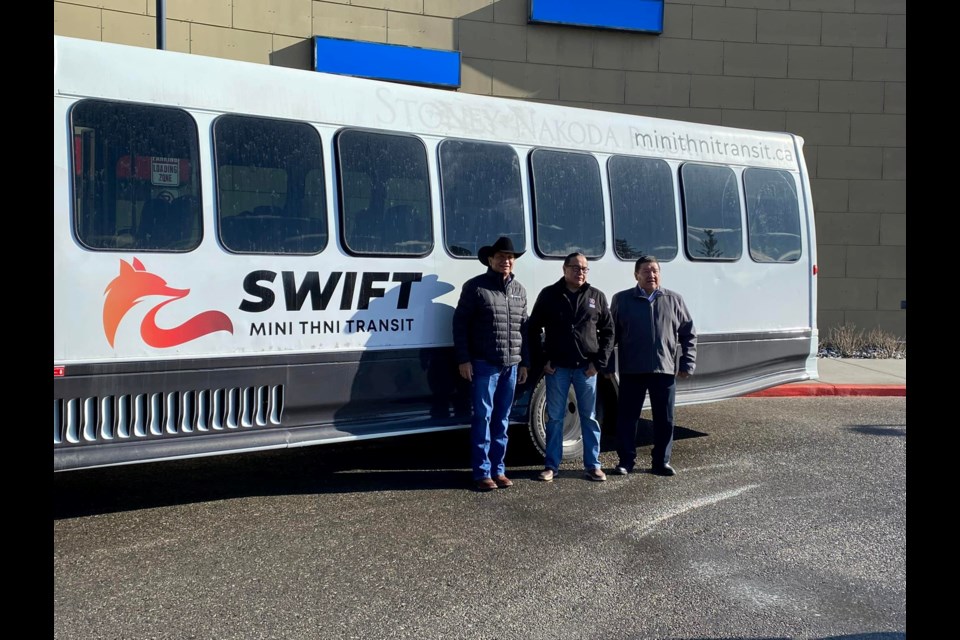STONEY NAKODA – The wheels of Swift Mînî Thnî Transit keep on turning.
What was initially proposed as a four-month public transit pilot project in Îyârhe (Stoney) Nakoda First Nation – the first of its kind on a First Nation in Canada – is now in its seventh month of operation, with more gas still left in the tank.
“We’ve been very judicious with the original grant monies that we received to maximize the time the pilot bus is running while we seek additional funding,” said Debbie Sailer, Swift transit program lead and executive administrative manager with Stoney Tribal Administration.
Costs have been kept low by making minor tweaks to the transit’s route schedule where ridership was low and by spending very little on marketing materials.
In June, the program adjusted its schedule to begin running buses later in the day, starting at 11 a.m. on Saturdays and Sundays instead of 9:30 a.m.
“We have to be really smart with our money so we’re looking at usage times carefully and we’re not out there doing a ton of marketing and giving away a ton of swag. We just don’t have the budget for that,” said Sailer.
Capital funding for the program was provided by the federal government’s Aboriginal Entrepreneurship Program which covers a broad range of pursuits aiming to build capacity, reduce barriers and increase access to capital by forging partnerships that increase economic opportunities for First Nations, Inuit and Métis people.
With the grant monies, Stoney Nakoda Nation was able to purchase an older model cutaway bus that was repurposed, including the addition of a new engine.
On March 24, Swift’s single low-floor 26-seat bus took its first ride, providing a safe, affordable local connection between Mînî Thnî (Morley), Chiniki Village and Stoney Nakoda Resort and Casino, with a regional connection to Cochrane.
The service provided free rides on its first day and then began selling tickets for $5 one way and books of 10 tickets for $50. Children aged two and younger continue to ride free.
Through negotiation with Stoney Nakoda Nation, Southland Transportation is operating the transit program in its pilot phase. If the program becomes permanent, the plan is for Îyârhe Nakoda Nation to take control of operations. The data gathered from this project will help evaluate future needs.
Sailer said ridership data is still being collected to determine the feasibility of continuing the program past its pilot phase, but the number of people using the bus each day has been steady overall.
Ridership is especially high on days when there are social or cultural events happening around Mînî Thnî, such as powwows or Treaty Days or when there are events in Cochrane.
“With some of the different things happening in the community, there are days when it’s full and the bus is running back and forth to get people where they need to be, whether that’s to an event or getting groceries in Cochrane,” said Sailer.
From Cochrane, public transit users can go one step further and hop on a Southland On-It bus from the same Swift drop-off point, to Calgary.
“Transit is no longer a nice-to-have, it’s a need-to-have,” said Sailer. “First Nations communities are especially isolated and we’re only dealing with Mînî Thnî right now.”
In the future, Sailer said she hopes the transit system can expand to include all Îyârhe Nakoda First Nation communities, including Big Horn, about a three-hour drive north of Mînî Thnî, and Eden Valley, about an hour and a half south.
“When you look at the reserve … it’s a vast area. If we could secure operational funding and get capital to invest in our program, then we can look at expanding to those other communities to connect the entire Nation, or maybe we could expand west and partner with Roam in Canmore and Banff,” she said.
Sailer is currently looking into advertising opportunities on the bus to boost revenues collected from ticket sales, which do not cover the operational costs of the program. Stoney Tribal Administration has also applied for other grants to support the program, with emphasis on the need for ongoing operational funding.
In June, Swift launched a survey to better understand ridership demographics and reasons for using the service.
The impetus behind the project began with discussions of providing a safe method of transportation in response to the number of Missing and Murdered Indigenous Women and Girls and Two-Spirited people (MMIWG2S+).
The survey began in June and ran for about five weeks. Results revealed the service is being used almost equally by self-identifying males and females, but young women made up for most of the riders in the first couple weeks, seemingly taking to the survey earlier than other demographics to share their feedback on the service.
“The idea, which predates my time with Stoney Tribal Administration, was to provide that protection which is a safe way to get into town without having to hitchhike or walk,” said Sailer. “I think, based on what we’re seeing and what we’re hearing, there are less people walking on Highway 1A which is dangerous enough for pedestrians and vehicles with the lack of shoulders.
“If we can move that needle ever so slightly and get more people from A to B safely, then it’s successful.”
The Local Journalism Initiative is funded by the Government of Canada. The position covers Îyârhe (Stoney) Nakoda First Nation and Kananaskis Country.




